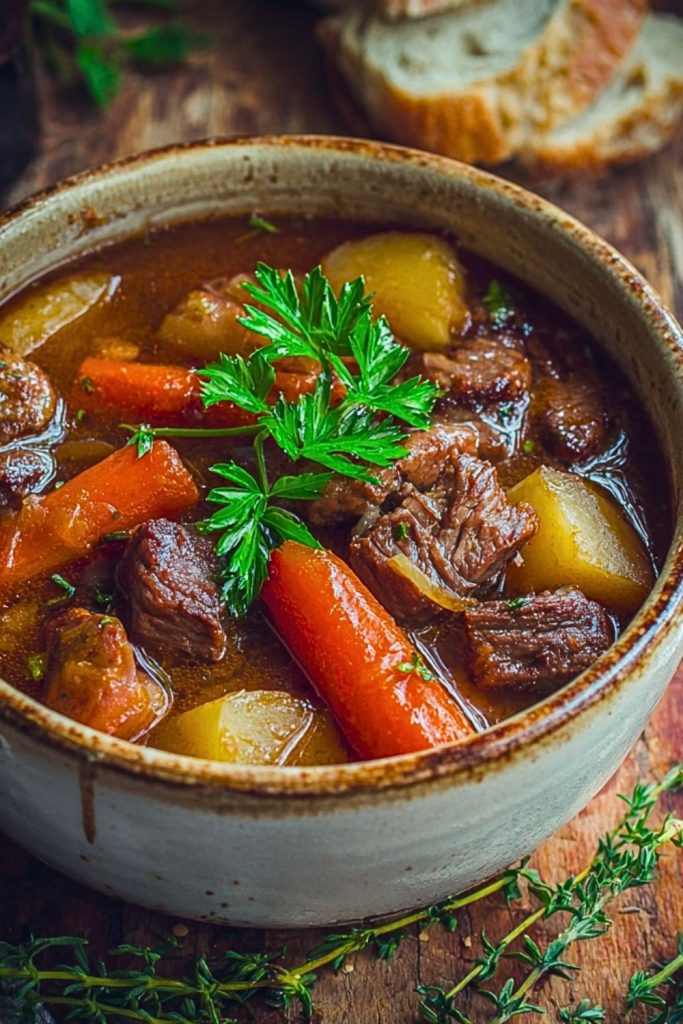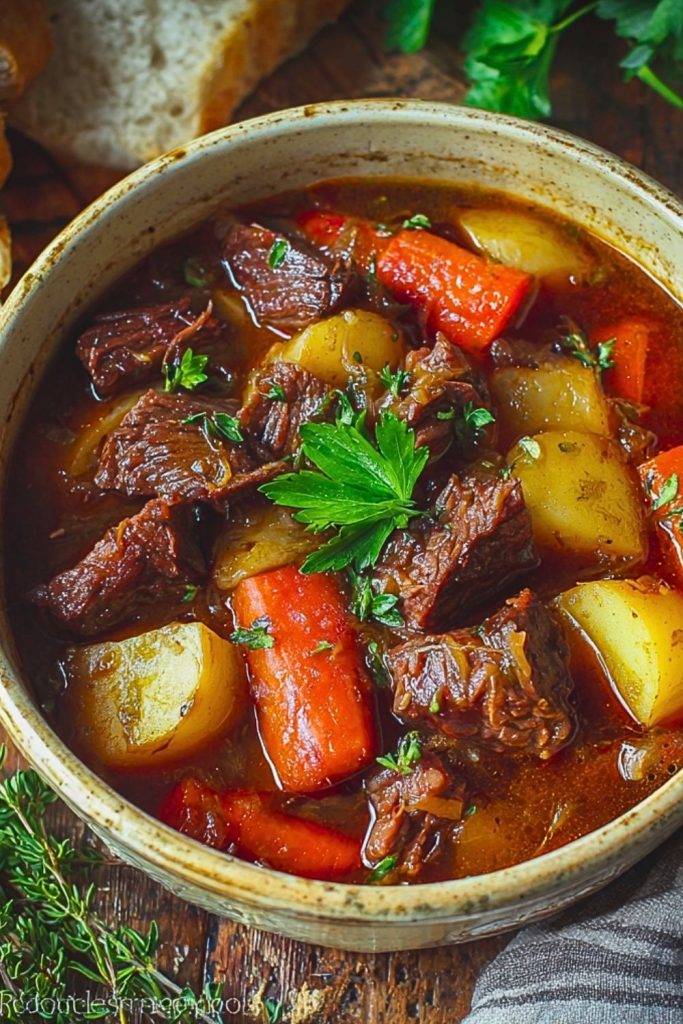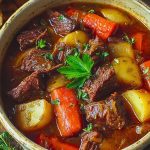When the weather cools down and the evenings stretch a little longer, there’s nothing quite as comforting as a big bowl of beef stew. The aroma of tender beef simmering with root vegetables in a rich, savory broth fills the kitchen and wraps you in warmth before you even take your first bite. I’ve made this stew more times than I can count, and every time it hits the table, it disappears fast. It’s a timeless classic that feels like a big, cozy hug in a bowl.

This version of The Best Beef Stew is the one I keep coming back to because it balances hearty meat, earthy vegetables, and a perfectly seasoned broth. It’s slow-cooked to tender perfection, and the flavor gets even better the next day—if you manage to have any leftovers, that is. Whether you’re feeding a crowd or just craving a comforting solo dinner, this stew delivers big-time satisfaction.
Why You’ll Love This Beef Stew Recipe
This beef stew isn’t just good—it’s everything you want in a one-pot meal. The beef becomes incredibly tender as it slowly cooks in the rich, flavorful broth. Carrots, potatoes, peas, and herbs give it just the right balance of texture and depth. It’s also incredibly adaptable: you can swap ingredients based on what you have on hand, and it’s great for meal prep. The best part? It all comes together in a single pot, which means minimal cleanup and maximum comfort.
What Cut of Beef is Best for Beef Stew?
When it comes to beef stew, the cut of meat makes a huge difference. I always go for chuck roast, cut into chunks. It’s affordable and becomes meltingly tender after a long simmer. Stew meat that’s pre-cut and packaged can be convenient, but it’s often a mix of cuts that don’t cook evenly. Stick with well-marbled beef chuck, and you’ll be rewarded with that classic, hearty texture and deep beefy flavor.
You can also use brisket or bottom round if chuck isn’t available—just make sure you give it enough time to break down and get fork-tender. The goal is meat that practically falls apart with every bite.
Options for Substitutions
If you need to make a few swaps, this stew is flexible enough to handle it without losing its soul.
- Meat: Try lamb shoulder or even pork shoulder for a different flavor. For a vegetarian version, use mushrooms and lentils.
- Potatoes: Yukon Golds hold up beautifully, but russet or red potatoes work too.
- Carrots: Parsnips or sweet potatoes can replace carrots for a sweeter, earthier profile.
- Peas: Green beans or chopped spinach stirred in at the end are great alternatives.
- Broth: If you’re out of beef broth, chicken broth or even vegetable broth will still make a delicious base.
- Red Wine: Adds depth, but you can skip it and use more broth, or a splash of balsamic vinegar for richness.
These swaps can make the stew fit your pantry and your taste buds perfectly.
Ingredients for This Beef Stew Recipe
Each ingredient in this stew plays an essential role in building deep, layered flavor and heartiness.
- Beef Chuck Roast: This is the star of the stew. Its marbling breaks down during slow cooking, making the meat incredibly tender and flavorful.
- Yellow Onions: They lay the aromatic foundation and add a sweet, mellow depth once cooked down.
- Garlic: A few cloves go a long way to enhance the stew’s savory richness.
- Carrots: They add natural sweetness and become beautifully tender, balancing the hearty beef.
- Baby Potatoes: These hold their shape well and absorb the broth’s flavor without turning mushy.
- Frozen Peas: Stirred in at the end, they add a pop of color and freshness.
- Tomato Paste: This thickens the broth slightly and adds concentrated umami and acidity.
- Beef Broth: Forms the hearty base of the stew, soaking into every bite with richness.
- Red Wine: Deepens the flavor and brings a touch of sophistication to the dish.
- Flour: Lightly coating the beef before browning helps thicken the stew as it simmers.
- Bay Leaves & Fresh Thyme: These herbs infuse the stew with aromatic complexity.
- Salt & Pepper: Essential for seasoning and bringing everything together.
Each element combines to create a stew that’s rich, comforting, and deeply satisfying.

Step 1: Brown the Beef
Start by cutting the beef chuck into bite-sized chunks. Pat them dry with paper towels—this helps them brown better. Season with salt and pepper, then lightly coat the pieces in flour. In a large Dutch oven or heavy-bottomed pot, heat a bit of oil over medium-high heat and sear the beef in batches. Don’t overcrowd the pan. You want that nice brown crust for maximum flavor. Remove the browned beef and set it aside.
Step 2: Sauté the Aromatics
In the same pot, reduce the heat to medium. Add a little more oil if needed, then toss in chopped onions and sauté until translucent and slightly golden. Add the garlic and cook for another minute, just until fragrant. Stir in the tomato paste and let it caramelize for a minute—it should darken slightly in color.
Step 3: Deglaze and Build the Broth
Pour in the red wine to deglaze the pan, scraping up all the flavorful browned bits from the bottom. Let the wine simmer for a couple of minutes to reduce slightly. Then pour in the beef broth, and return the browned beef (and any juices) to the pot. Add bay leaves, fresh thyme, and a pinch more salt and pepper. Bring it all to a simmer.
Step 4: Add the Vegetables and Simmer
Toss in the chopped carrots and halved baby potatoes. Reduce the heat to low, cover the pot, and let everything simmer gently for about 1½ to 2 hours. Stir occasionally, and check the liquid level—add a splash of broth or water if it gets too thick.
Step 5: Finish with Peas and Adjust Seasoning
About 10 minutes before serving, stir in the frozen peas and let them heat through. Taste the stew and adjust with more salt or pepper as needed. Remove the bay leaves and thyme stems before serving.
How Long to Cook the Beef Stew
The secret to this stew’s tenderness lies in its slow cooking. After browning the beef and building the broth, the stew needs to simmer gently on low heat for 1½ to 2 hours. This allows the beef to break down and become fall-apart tender while the vegetables absorb all that savory goodness. You’ll know it’s ready when the meat is easy to shred with a fork, and the potatoes are soft but still intact.
If you’re using a slow cooker, cook on low for 7–8 hours or on high for 4–5 hours. In the oven, you can bake it at 325°F (160°C) covered for about 2½ hours.
Tips for Perfect Beef Stew
- Don’t skip the browning. Searing the beef builds flavor you won’t get from boiling alone.
- Use a heavy-bottomed pot. It helps maintain even heat and prevents burning.
- Simmer low and slow. A gentle simmer is key to tender meat and rich broth.
- Cut veggies into uniform pieces. This ensures they cook evenly and finish at the same time.
- Add peas at the end. They stay bright and tender, not mushy.
- Taste before serving. Adjust salt and pepper at the end for the perfect balance.
These small touches make a big difference in crafting the ultimate bowl of comfort.
Watch Out for These Mistakes While Cooking
Even a simple stew can go sideways if you miss a few key details. Here are the common pitfalls to avoid:
- Skipping the beef browning step: It’s tempting to save time, but this step builds the stew’s deep, savory flavor.
- Boiling too vigorously: A rolling boil will toughen the meat and turn your vegetables to mush. Always simmer gently.
- Adding all vegetables at once: Potatoes and carrots need time, but delicate peas should go in last to keep them vibrant.
- Using the wrong pot: Thin pots don’t hold heat well and can lead to uneven cooking or burnt bottoms.
- Under-seasoning: Always taste and adjust near the end. The long cook can mellow flavors, so a final seasoning check is key.
What to Serve With Beef Stew?
Crusty Bread
A good rustic loaf or baguette is perfect for soaking up every last drop of the rich broth.
Buttered Egg Noodles
These make a hearty base if you want to stretch the stew or change up the texture.
Mashed Potatoes
Creamy mashed potatoes complement the stew’s richness and make it extra filling.
Steamed Green Beans
A crisp, fresh veggie side adds color and balance to the meal.
Garlic Roasted Broccoli
Bold and flavorful, this side pairs nicely with the savory stew without overpowering it.
Side Salad
Something fresh and acidic, like a vinaigrette-dressed green salad, helps cut through the richness.
Polenta
Creamy polenta offers a smooth and satisfying contrast to the chunky stew.
Pickled Vegetables
A small side of something tangy can brighten the plate and enhance the deep flavors of the stew.
Storage Instructions
Beef stew stores beautifully, making it a great option for leftovers or meal prep. Once it cools, transfer the stew to an airtight container and refrigerate. It will stay fresh in the fridge for up to 4 days. In fact, it often tastes even better the next day as the flavors continue to meld.
For longer storage, freeze the stew in freezer-safe containers or zip-top bags, leaving a little room for expansion. It will keep well for up to 3 months. To reheat, thaw overnight in the fridge and warm gently on the stovetop or in the microwave.
Estimated Nutrition
Please note that these values are approximate and may vary based on exact ingredients used:
- Calories: 420 per serving
- Protein: 32g
- Carbohydrates: 28g
- Fat: 20g
- Saturated Fat: 7g
- Cholesterol: 90mg
- Fiber: 5g
- Sodium: 780mg
- Sugar: 6g
This beef stew is a well-balanced meal with plenty of protein and vegetables, offering warmth and nourishment in every bite.
Frequently Asked Questions
Can I make beef stew in a slow cooker?
Absolutely! After browning the beef and sautéing the aromatics, transfer everything to a slow cooker. Cook on low for 7–8 hours or high for 4–5 hours for tender, flavorful results.
What can I use instead of red wine?
You can substitute red wine with additional beef broth or a splash of balsamic vinegar for depth and acidity.
How do I thicken the stew if it’s too watery?
If the broth is too thin, you can mix a tablespoon of cornstarch with cold water and stir it in. Let it simmer a few more minutes until thickened.
Can I use frozen vegetables?
Yes, frozen carrots or peas work well. Just add them towards the end of cooking to avoid overcooking.
Why is my beef stew meat tough?
It likely hasn’t cooked long enough. Chuck roast needs low, slow cooking to break down its tough fibers and become tender.
Can I prep this stew ahead of time?
Definitely. You can make the entire stew a day in advance—it tastes even better after resting overnight in the fridge.
Is it okay to leave the stew out overnight?
No, it should be refrigerated within 2 hours of cooking to avoid food safety issues.
Can I make this in an Instant Pot?
Yes, brown the beef using the sauté function, then pressure cook everything for about 35 minutes with a natural release.
Conclusion
The Best Beef Stew is more than a meal—it’s a comforting ritual, a dish that brings warmth and satisfaction no matter the season. It’s rich, hearty, and filled with layers of flavor that only get better with time. Whether you’re cooking it for your family, a gathering of friends, or just for yourself on a chilly evening, this stew is sure to become a staple in your kitchen. Give it a try and let the aroma alone win you over.

The Best Beef Stew Recipe
- Prep Time: 20 minutes
- Cook Time: 2 hours
- Total Time: 2 hours 20 minutes
- Yield: 6 servings 1x
Description
The Best Beef Stew is a comforting one-pot meal made with tender chunks of beef, hearty vegetables, and a rich, flavorful broth. It’s slow-simmered to perfection and ideal for cozy dinners, meal prep, or family gatherings.
Ingredients
- 2 lbs beef chuck roast, cut into chunks
- 2 tablespoons flour
- 2 tablespoons olive oil
- 1 large yellow onion, chopped
- 3 garlic cloves, minced
- 2 tablespoons tomato paste
- 1 cup red wine (optional)
- 4 cups beef broth
- 3 large carrots, sliced
- 1½ lbs baby potatoes, halved
- 1 cup frozen peas
- 2 bay leaves
- 2 sprigs fresh thyme
- Salt and black pepper, to taste
Instructions
- Pat the beef chunks dry and season with salt and pepper. Toss with flour to coat lightly.
- In a large pot, heat olive oil over medium-high heat. Brown the beef in batches, then set aside.
- Lower the heat to medium. Sauté onions until translucent, then add garlic and cook for 1 minute. Stir in tomato paste.
- Deglaze with red wine, scraping up browned bits. Let it reduce for 2–3 minutes.
- Add beef broth, browned beef, bay leaves, and thyme. Bring to a simmer.
- Stir in carrots and potatoes. Cover and simmer on low for 1½ to 2 hours, stirring occasionally.
- In the final 10 minutes, add peas. Adjust seasoning with salt and pepper. Remove bay leaves and thyme stems.
- Serve hot with your favorite side.

